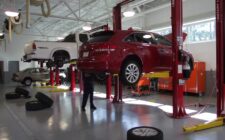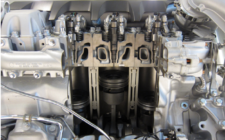If you’ve had your photo taken with friends during a night out at a dimly lit bar, you know that lighting is everything. It matters for our social media posts, it matters for reading, and it matters for driving.
You can’t always control the quality and quantity of streetlights, but you can control how effective your vehicle lights are. Proper headlights- and the other lights on your car-are crucial to your safety and the safety of your passengers and other people on the road. That’s why proper lighting maintenance is essential to collision repair.
Vehicle lighting and collision repair
The lights on your vehicle affect collision repair in two basic ways.
- Prevention: Good vehicle lights—when used properly—help avoid collisions. If you maintain your lights and use your signals appropriately, your chances of staying out of collisions, and thus ensuring your safety and saving money by not having to pay for auto body repair, are much higher.
- Light repair and replacement: The various lights on your vehicle may become damaged in a collision. A head-on impact or a rear-ender can easily smash your headlights or tail lights. If so, a collision repair technician will have to replace them, and perhaps repair the wiring or casings. Vehicle light maintenance is also a key auto body repair service.
How to use your lights to avoid collisions
Why are vehicle lights important for avoiding collision repair? The different lights can help with different issues, such as:
Visibility
Let’s start with the obvious: You have to see where you’re going. Streetlights only do so much and you can’t always depend on them to be there, especially when driving in rural areas. Effective headlights are both important for increasing your safety. If your lights are dim, it’s not as simple as just avoiding driving at night.
First, you can’t always control plans and traffic, so you might be out later than you intended. Also, there are numerous daytime conditions- rain, snow, fog, and intense cloud cover—that can severely reduce visibility and require the use of headlights. Having healthy, properly functioning headlights is non-negotiable for all drivers.
Unfamiliarity
High beams are also a visibility tool, but not one you should use all the time. Still, it’s important to ensure your high beams perform properly if you’re going to avoid collision repair. Here’s when to use your high beams:
- When you’re in an unfamiliar, dark area: If you’re driving at night somewhere new, and street lighting is poor, it’s good to have high beams. You don’t want to use them if there’s lots of other traffic, but they can help you see where you’re going. Just remember, if you’re on roads you don’t know, drive slowly, or you might have to find a local auto body repair shop.
- On a rural highway: Rural routes often don’t have streetlights, or at least not many. On these roads at night, it’s wise to use your high beams, but only if traffic is sparse. You don’t want to blind other drivers with your high beams.
- When it’s dark and clear: If it’s raining, snowing, or foggy in either of the scenarios above, it’s best to not use your high beams. The intense light from the high beams will reflect off the water droplets in the atmosphere. Normal headlights (provided they’re maintained properly) cut through this moisture better.
Being seen
Your headlights help you see, but they also help others see you. If your headlights aren’t working, other drivers, cyclists, and pedestrians may not see you coming. The consequences could be disastrous; paying for a collision repair could be the least of your problems. Also, properly functioning tail lights help prevent drivers behind you crashing into your vehicle.
Communication
Turn signals and brake lights are your way of communicating with others on the road. There’s a reason traffic officers will write you a ticket if your turn signal is out (or if you just don’t use it). These signals are crucial for indicating your intentions so others know when you might turn, change lanes, or break.
Vehicle lighting maintenance
An ounce of vehicle maintenance is worth a pound of auto body repair, as the old saying kind of goes. So, what can you do to ensure your lights are working at optimal levels to avoid collisions and collision repair?
Light inspections
Perform regular visual checks on your headlights, brake lights, and turn signals. It’s also helpful to get a family member or friend to confirm that all lights are functioning, or use a surface, such as your garage door or a wall, and look at the strength of the reflections coming back.
Clean your lights
Build up of dirt, grime, and rust can reduce brightness. A few times a year, clean the lenses of your vehicle lights with a mild soap and water solution. There are also headlight restoration kits available if the lenses are cloudy or yellow.
Replace bulbs in pairs
If one bulb goes out, the other may soon follow. Replacing both ensures they shine evenly.
Upgrade to LED or HID Bulbs
If your vehicle is compatible with them, consider LED or HID bulbs. These are brighter and last longer than halogen bulbs. One caveat: some prefer not to purchase the absolute brightest LED and HID bulbs, as these can annoy other drivers, kind of like driving with your high beams on all the time.
Don’t ignore warning signs
Dim or flickering lights might be a sign of an electrical issue, such as a failing alternator. If multiple lights are dim, test your battery and charging system. Don’t ignore these issues and just hope they get better. Also, there’s one type of light we haven’t discussed yet: the warning light. If a warning light pops up on your dash for any reason, tend to the matter yourself or visit an auto body repair shop.
Visit a collision repair shop to ensure your lights are working
Technicians can adjust misaligned headlights, check potentially faulty electrical connections, and inspect and replace fuses. If you have a light issue, visiting an auto body repair shop to get it looked at is a much better option than having to come in for a full-on collision repair.




